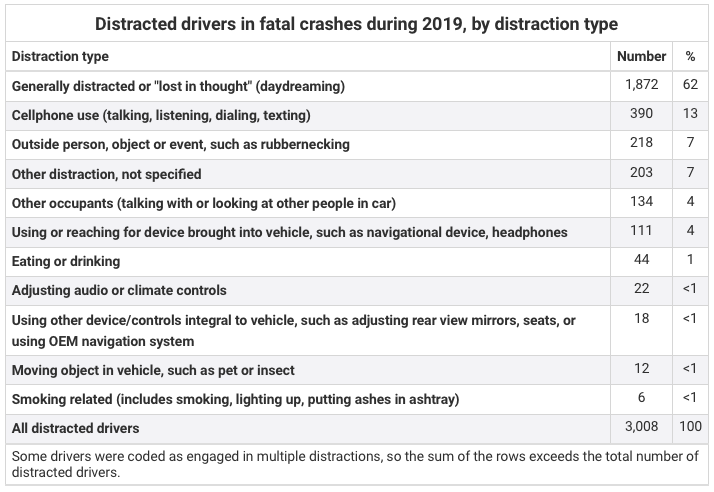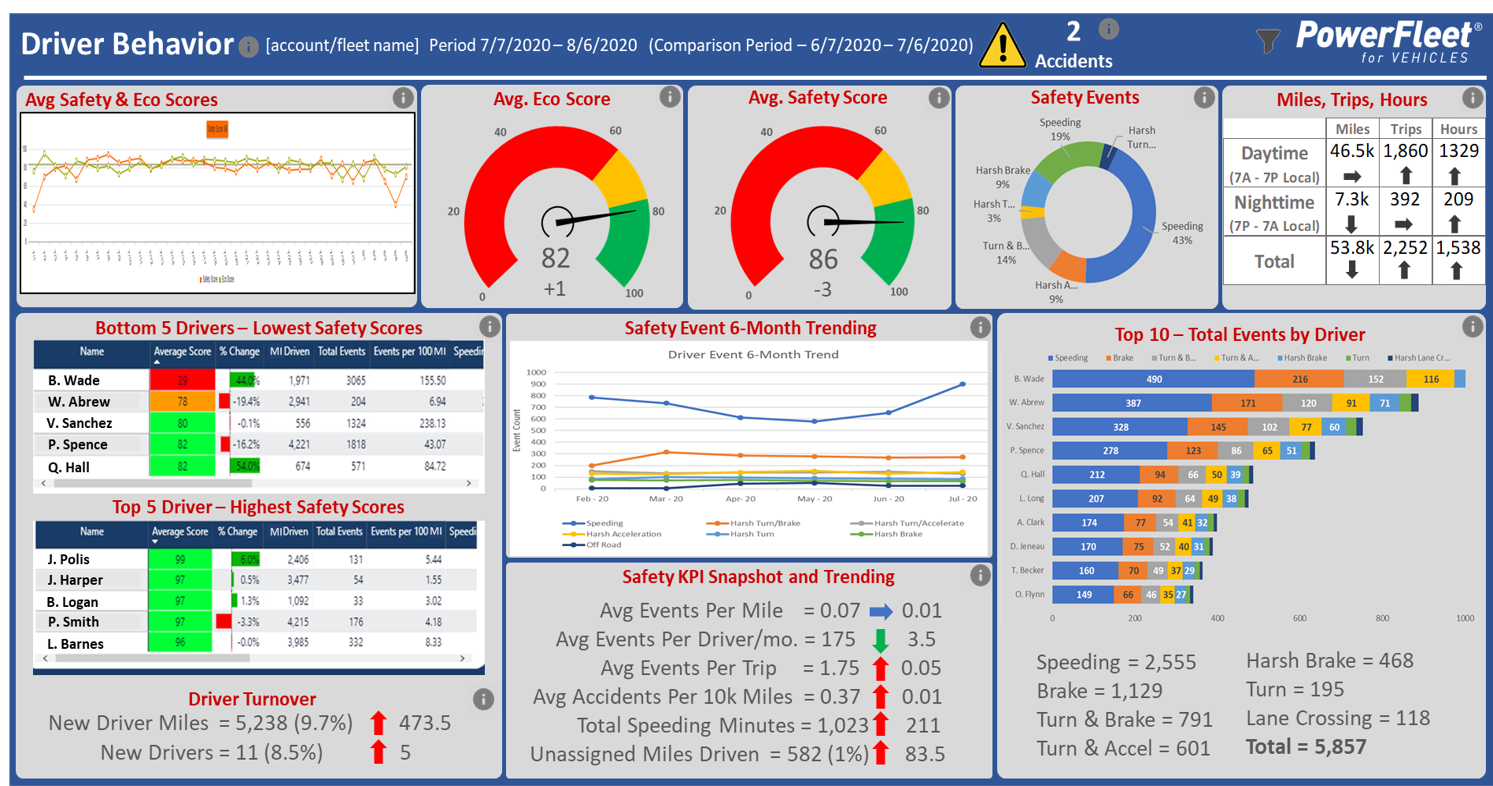Many service businesses deliver their services at customer sites, which requires company vehicles and employee drivers. While accidents are rare, they can be extremely costly in terms of property damage, lost productivity, missed sales calls and potential third-party liability claims from at-fault crashes—and technology can play a key role in mitigating these costs.
Let’s take a look at the high cost of unsafe driving, how to implement the right policies and the role that technology plays in encouraging good driving behaviors.
Telematics can play a key role in improving driver behavior and reducing crash risks for private/service fleets. Share on XThe Causes & Costs of Unsafe Driving
The number of motor vehicle deaths and crashes per capita have steadily fallen since 1975, according to the U.S. Department of Transportation’s Fatality Analysis Reporting System (FARS). While safety improvements have made a big impact on these metrics over time, there were still 33,244 crashes and 36,096 deaths on American roads in 2019.
Speeding was a factor in 26% of motor vehicle accidents over the past decade and the percentage of crash deaths involving speeding was higher on minor roads (31%) compared to interstates (29%) or major roads (23%). About half of all speeding-related fatalities occurred on roads with posted speed limits of less than 55 miles per hour.

Types of Distracted Driving – Source: DOT
Distracted driving accounted for about six percent of fatal crashes in 2019, although the National Safety Council believes that it could be underreported or inconsistently reported. While daydreaming was the primary cause of distraction (62% of cases), cell phone use was associated with 13% of these fatal crashes.
Fleet vehicle accidents are among the most expensive injury claims for businesses, according to Automotive Fleet. Aside from property damage, fleet crashes have a lot of other costs and potential third-party liability claims from an at-fault crash. Since most businesses self-insure their fleet, companies are directly responsible for these costs.
Prevention Training, Policies & Procedures
The first step in encouraging safe driving and preventing costly accidents is implementing the right training, policies and procedures. In addition to setting standards for drivers to prevent accidents from occurring in the first place, documenting training provides physical evidence that fleets prioritized safety, which can help limit liability in at-fault crashes.
A common source of distracted driving is an unrealistic expectation that field employees be working 100% of the time. When drivers feel compelled to use company vehicles as mobile offices and multitask, there’s a much higher risk of an accident or crash due to distracted driving, so companies should have the right expectations on their end.
Routes and schedules also need to be realistic in order to encourage safe driving. If there’s too little time between appointments, drivers may be tempted to speed to make it to appointments on time, which increases the risk of a crash. Flexibility in scheduling is key to ensure that drivers have enough time to both satisfy customers and make it safely to their next appointment.
A great way to improve safety on the road and maintain productivity is to add a second person to each job. With two people in the vehicle, the driver can focus on the road while the passenger can focus on work-related tasks, such as checking directions, gathering job details, contacting the customer, talking to dispatch or handling other common tasks.
How Technology Improves Safety
Technology has helped dramatically improve safety on the road. Aside from seatbelts and airbags, modern vehicles are equipped with sensors that warn drivers of a potential impact and even apply the brakes to avoid or mitigate the impact. New vehicles are constantly improving their safety ratings and keeping drivers and passengers safer on the road.
Modern fleet telematics and dashboard cameras have also made it easier for drivers to receive instant feedback on their driving style and for fleet managers to remotely access driver behavior. The instant feedback to drivers while they are driving and the consistent reinforcement of good driver behavior, provides the opportunity to create a strong self-sustaining safety culture. In addition to creating clear policies and training programs, managers can also monitor driver behavior in real-time and look for instances of speeding, hard braking, sudden acceleration or minor impacts. They can also quickly determine the real-time locations of vehicles at all times if an incident happens.
Fleets can use the real-time telematics data to assess driver behavior and address any problems before incidents occur. While penalizing drivers with a poor record seems like a natural choice, fleets should consider creating reward programs for good driving behaviors. The Hawthorne Effect will naturally encourage better driving behavior. Dispelling myths and providing transparent communication with employees about the technology being used in vehicles can help establish trust and buy-in.
Telematics can also help improve the driver and customer experience by setting the right expectations. With the right data in hand, fleets can more accurately estimate arrival times, job times and optimal routes. Companies can even configure automatic alerts that inform customers when a technician is on the way without the need for a phone call.
The Bottom Line
Technology has dramatically improved driver safety over the past few decades, but there are still an alarmingly high number of fatal and non-fatal crashes each year. Accidents can be particularly costly for private fleets, which tend to face greater liability than the general public and must grapple with the costs of lost productivity and missed sales calls.
In addition to the right training policies and procedures, modern telematics can help fleets remotely monitor driver behavior in real-time while unlocking a number of other benefits, such as improved scheduling, proactive maintenance, fuel efficiency monitoring and location-based data that can help dispatchers coordinate appointments.
Of course, the key to a successful implementation of these telematics solutions is finding the right vendor that can help with both installation and usage. All the data in the world isn’t very helpful if it’s not available in an actionable format and actually acted upon by managers.

Powerfleet for Vehicles Reporting Example – Source: Powerfleet
Powerfleet for Vehicles provides a range of telematics solutions designed to help private fleets achieve better safety records and minimize risk at an affordable cost. Fleets can access all of the data that they need on a single dashboard that provides information on fuel efficiency, safety events and individual driver track records. Contact us today!


